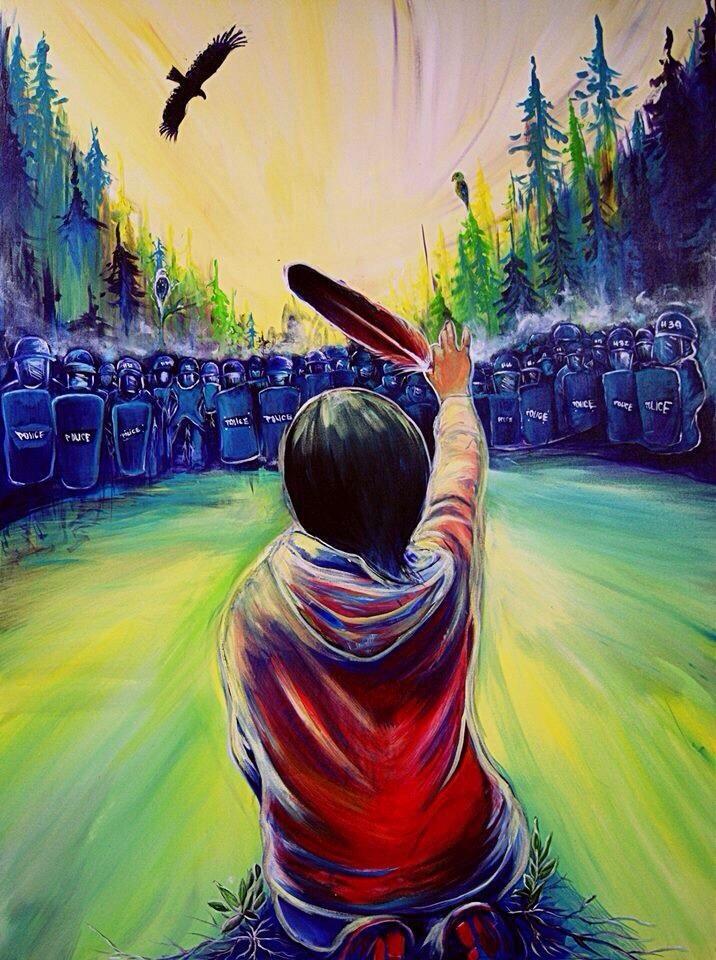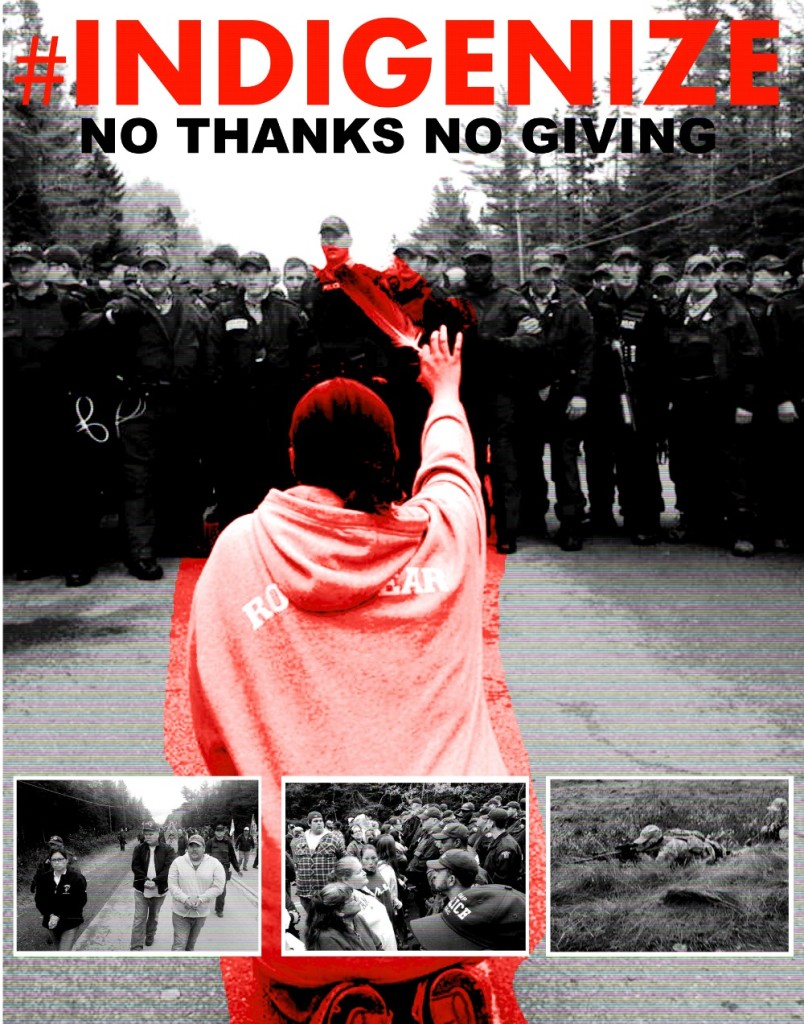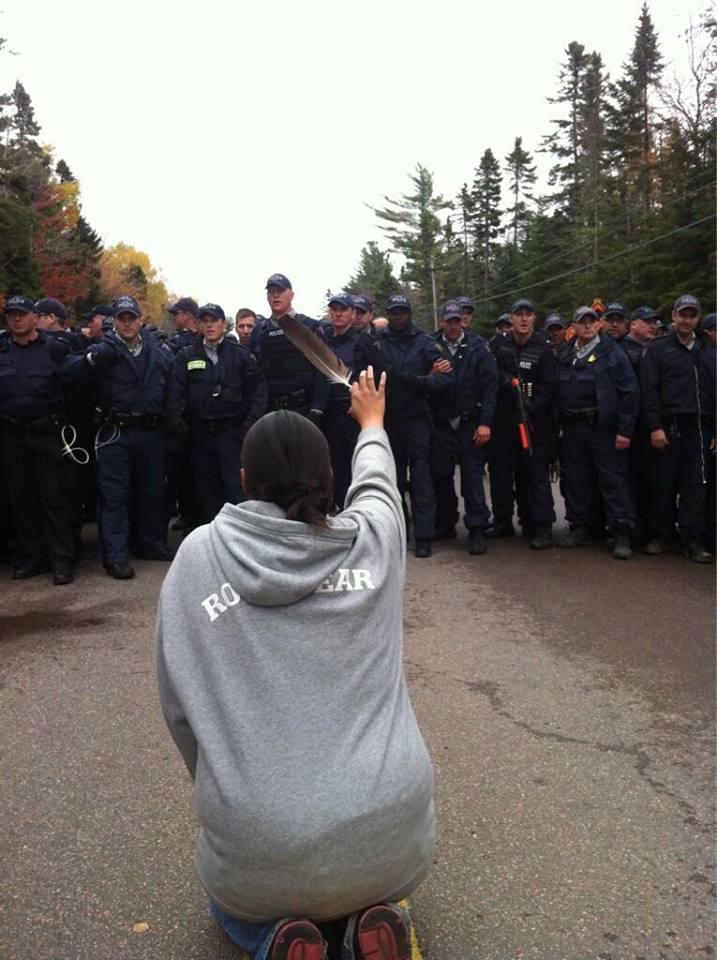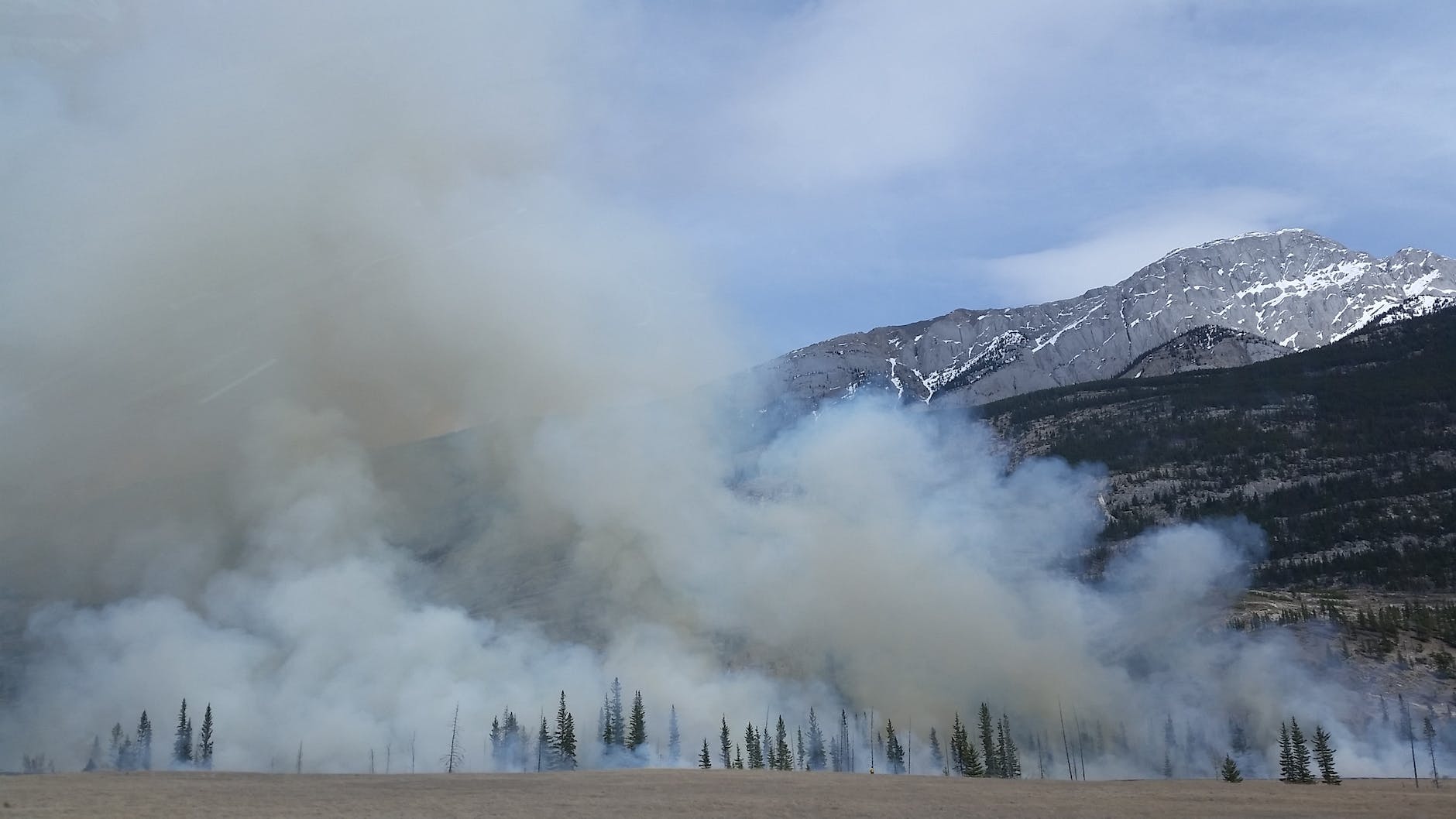
A beautiful reworking of an iconic image from Elsipogtog, by artist Fanny Aishaa. The original photo was taken by Ossie Michelin, a reporter for APTN and the woman is Amanda Polchies.
Though I will be writing on the events that took place on October 17, 2013 (timeline put together by Dylan Powell) when the RCMP raided a peaceful blockade by members of the Elsipogtog Mi’kmaq First Nation, for now I just want to provide people with some already available and excellent resources on the subject. What I won’t be doing is linking to the plethora of unbelievably racist articles that are pouring out, branding the people of Elsipogtog as everything from terrorists, to puppets of environmental NGOs. These pieces already have mainstream attention, capture mainstream attitudes towards indigenous peoples, and are pretty successfully creating the official narrative.
If you want to delve deeper, or need resources with which to counter these portrayals, here you go!
If you have time for only one article, then you need to read this one, written by Martin Lukacs: “New Brunswick fracking protests are the frontline of a democratic fight.”
It does an excellent job of refocusing attention on the reason the blockade existed in the first place, and on the fact that the area in question has never been ceded to Canada, and thus is not owned by Canada. The people of Elsipogtog have been branded as law breakers, but the legality of Canadian actions in that area are completely undermined by this very central fact.
To keep us in that vein, here is an article from 2012 which discusses the fact that 67% of people in New Brunswick support a moratorium on fracking. This is an intensely controversial practice and people throughout Canada and the US, native and non-native alike, stand in opposition to it. The people of Elsipogog are not on the fringe of an issue here, they are in the majority.

One of a series of posters put together by tumblr user flailingphantasm for October 18th solidarity actions.
For a really good breakdown of arguments about the rule of law, as it is so lopsidedly applied in this case, Daniel Wilson provides us with, “Out of order: Indigenous protest and the rule of law“. He brings up some important issues about the public’s love affair with the ‘rule of law’ from such a distinctly one-sided perspective, which ignores the underlying illegitimacy of Canadian claims to the land in question and the unceasing violation of the ‘rule of law’ by the Crown.
For a more fullsome legal analysis of ‘rule of law’ as it pertains to Aboriginal peoples, this invaluable article by OKT Law is a hard counter to the arm-chair lawyers that populate comment sections and who advocate cracking down on indigenous peoples: “Do we need the ‘Rule of Law’ in New Brunswick to deal with native protestors?” This article, along with the Lukacs article are probably two of the best resources you can use to learn about the issue, and counter the misinformation out there.
This article: “Elsipogtog “Clashes” 400 years in the making”, by Dru Oja Jay, goes into good detail about some of the history of the area, and how high tensions have run between the Mi’kmaq and the Canadian government. State violence against the Mi’kmaq people has been an ongoing problem, and Elsipogtog is merely the latest in a line of such.
Lesley Belleau describes the cycle of abuse between the Canadian state and indigenous peoples as expressed in what happened to the people of Elsipogtog. Her piece, “Elsipogtog: The Realities of Abuse” helps name the behaviours and the coping strategies used, as well as locating this specific incident in a wider history of a a relationship gone terribly wrong.
Graeme Decarie discusses ‘legal’ versus ‘right’ in a blog post and goes into detail as to how the events in Elsipogtog are part of a wider issue facing all people in New Brunswick and throughout Canada.
Leanne Simpson, in her brilliant piece “Elsipogtog Everywhere” brings more context to the deeper issue of the land, and the way in which reconciliation cannot occur without a conversation about that land. If you need to know what deeper acts of resurgence are occurring outside of reactive blockades to deal with lack of consultation and the prioritising of corporate interests over the wishes of all people living in the area, then this article provides it. This is one of the most honest and hopeful pieces I have read on the subject, and it helped me deal with the flood of emotions I’ve been experiencing since watching this all go down on October 17th.
By the way? What the heck is fracking? Here is a video that provides a simple, clear description of the process of fracking, summarising the pros and cons: “CNN Explains: Fracking“.
Recently, a claim was made by He Who Shall Not Be Named (because the guy literally gets paid to troll, and every little mention puts more money in his bloated pocket) that the people of Elsipogtog are basically puppets of foreign environmental groups. The article “Fracking Indigenous Country” (under the donation appeal) is a very long, but detailed rebuttal of any such claims. If you were at all wondering about whether this could be true, this article does an amazing job of completely demolishing these fantasies.
Rex Murphy really put his foot in it as well. Here are two very good responses to his patronising, racist article: “Rex Murphy and the Frames of Settler Colonial War” by Corey Snelgrove, and “Dear Rex: Colonialism exists, and you’re it” by Nick Montgomery.
Jian Ghomeshi put out an audio essay on the incident, summarising the different opinions and posing some of the important questions the public needs to be asking. He also helps you learn how to pronounce Elsipogtog 🙂
There have been a lot of conspiracy theories going around about provocateurs and US military involvement and so on. Here is an incredibly detailed article by Gord Hill about the tactics and equipment used during the raid which should help dispel some of the most outlandish rumours without downplaying the level of violence initiated by the RCMP: “Overview of RCMP deployment against Mi’kmaq blockade, Oct 17, 2013.”
Another article by the same author questions the rumours about provocateurs setting fire to the RCMP vehicles: “Statement on Provocateurs, Informants, and the conflict in New Brunswick.” Snitch-jacketing, or labeling people as provocateurs or agents of the state is an incredibly divisive and dangerous practice and whether the rumours are spread by law enforcement or our own communities, we have to be careful.
While this next article is not about Elsipogtog, it is nonetheless a very important read. “An open letter to peaceful protestors” debunks a lot of the myths about way peaceful protest was used during the Civil Rights Movement, and clarifies the difference between peaceful, and legal. The need to be organised rather than simply reactive, is highlighted and explained. Every person wanting to be involved in any sort of protest, solidarity action or larger movement, needs to read this article and really think about what it is saying.
To wrap up, I want to thank the artists who have so quickly responded with their support of the movement.



30 Comments
clayton therrien · October 23, 2013 at 11:08 am
Once again, a brilliant exposition of available resources. – ¢ŧ….
Sylvia Smith · October 23, 2013 at 8:56 pm
I’ve never seen so many great resources all in one blog post! Brilliant! Thank you so much!
Colinda Clyne · October 23, 2013 at 11:11 am
Thanks so much! Was looking everywhere for appropriate credit for that amazing photo, and the art it has spawned. Will use these links in my FNMI class today to consider issues for FNMI in the news. I anticipate much thoughtful discussion.
Glen Douglas · October 23, 2013 at 1:43 pm
excellent report and writing as usual. great reporting migwech!!!!!!
Megan O. · October 23, 2013 at 1:48 pm
This is one of the best researched articles I have ever read. Thank you! More people need to be aware of the information and articles you’ve presented here. I will be sharing this article with everyone I know.
Craig Hubley · October 23, 2013 at 1:59 pm
Excellent start. Here are more:
Kent Bearwalker O’Grady offers a constitutional analysis of why Alward had no right to issue any permit to SWN Resources Inc., as the required consultation had not occurred. Nor, given the lack of assent by First Peoples to that constitution, and thirty years since in which no process of such consultation has been outlined for universal application, could any definition of consultation be enough. https://monctonfreepress.ca/post/23858 [His analysis mentions the Royal Commission on Aboriginal Peoples (RCAP) but fails to take into account the United Nations Declaration on the Rights of Indigenous Peoples (UN DRIP) and does not deal with the claim of AFN to have a veto on resource development in treaty territory even where modern treaties exist. But it’s good good legal references.]
Miles Howe, a journalist who was attacked and had his reporting resources confiscated at the protest site Thursday morning, has published the only firsthand account of events of any third party journalist. http://www.popularresistance.org/an-insiders-view-on-the-rcmp-raid-on-mikmaq-encampment/ This account is essential as it clarifies some facts that the mass media have been repeatedly (and in some cases – like Sun News Network – deliberately) misrepresenting. Among these:
*There was an undertaking between RCMP and Warriors not to attempt any enforcement of the ex parte interlocutory (i.e. very legally weak) injunction until after the first hearing on the merits Friday – an undertaking the RCMP broke, which certainly provoked some response.
*As of the site being cleared by the RCMP, no police cars were burning. This occurred after the site was cleared to RCMP satisfaction, by parties that could easily have been observed by police, and were observed by protesters, but were not. This provides strong evidence of provocateur action or at least an intent by police to generate a spectacular image that they could use to generate support.
*Nothing was thrown until after the police line was formed, and the “weapons” thrown were basically firecracker-class incendiaries and not “pipe bombs” nor “Molotov cocktails” in any reasonable use of those terms. The devices used were barely capable of setting a lawn chair on fire, were not heavy, and the armored officers were at far less risk from those than the crowd was from the rubber shotgun bullets or the tear gas or pepper spray used. The violence was instigated by RCMP alone.
Another fairly good list of resources, editable by the public, is this http://nb.referata.com/wiki/Resources – it is a very deep mediawiki-based resource including background on other NB issues especially energy policy issues (Point Lepreau, etc.) that should be expanded by adding the links and other materials presently being forwarded around the Internet, posted on blogs, and so on.
âpihtawikosisân · October 23, 2013 at 3:35 pm
Awesome, thanks for the further resources!
Glen Douglas · October 23, 2013 at 5:32 pm
Don’t know how you can use the provocateur card without being there. The people of Elispogtog should answer that question, not outsiders.
Craig Hubley · October 23, 2013 at 2:01 pm
Also, all my relations are welcome to “friend” me on facebook as I have posted many links to affidavits, rulings and press releases from Christian Peacemaker Teams, Tobic and other First Nations, etc.
Craig Hubley · October 23, 2013 at 2:08 pm
The most relevant SWN/fracking/Elsipogtog links are actually now up on the front page of nb.referata.com http://nb.referata.com/wiki/Main_Page
Cat · October 23, 2013 at 2:18 pm
Thanks as always.
Crystal · October 24, 2013 at 10:36 am
We support you – we, born in Canada, Quebec, some family French, some English, some European, little native ancestry, half French speaking, Quebecers, Canadians, we appreciate your work, native history, telling us your side and for all of us, working towards peace, and upholding this land sacred and clean the way God created it., for all His people. Thank you apihtawikosisan. Hopefully, and peacefully, we can remind government that we will not be bullied.
Roland · October 25, 2013 at 2:45 am
Thank you for all information and links. The timeline provided by Powell is very important. When i Following the protest on twitter and media in Canada the clashes seems to be very confusing and there are som many rumors.
Here in Sweden we have to battle the mining industry, greedy guts who profit on minerals. This summer there was a battle on Gállok near Jokkmokk.
http://barentsobserver.com/en/business/2013/09/mine-dispute-intensifies-arctic-sweden-30-09
Hold your ground and keep the battles peaceful. THEY have all the guns, we have our prayers.
Steve Plummer · October 27, 2013 at 6:42 pm
As I do not live in Canada, I do not know how the media is portraying this incident. What I do know is what I have been following on the many sites that I regularly read. From them I have gotten the TRUE STORY as told above. Please know that there are many that stand with you. Please keep us informed and be safe in the knowledge that you are RIGHT!
In solidarity with Elsipogtog | Au courant · October 23, 2013 at 1:23 pm
[…] Resources on Elsipogtog by âpihtawikosisân […]
Ecological Genocide | indieloudspeaker · October 23, 2013 at 3:09 pm
[…] For more information on the arrests of protestors of fracking of the Elsipogtog First Nations visit: https://apihtawikosisan.com/2013/10/23/resources-on-elsipogtog/ […]
Daily feminist cheat sheet · October 23, 2013 at 4:11 pm
[…] Mi’kmaq First Nation in New Brunswick (Canada, not New Jersey)? Here’s a good summary, and an excellent round-up of articles on Elsipogtog Mi’kmaq First Nation resistance to fracking in their […]
A Socialist in Canada » Federal police and New Brunswick government assault First Nations anti-fracking protest · October 24, 2013 at 1:02 pm
[…] * Keep the frack off our land, by Brian Ward and Ragina Johnson, Socialist Worker, October 22, 2013 * Resources on Elsipogotg, by âpihtawikosisân, published on her blog, Oct 23, 2013 […]
Resources on Elsipogtog » Delusions of Development · October 25, 2013 at 1:18 pm
[…] piece was originally posted at âpihtawikosisân, Law, language, life: A Plains Cree speaking Métis woman in Montreal. Re-posted here with permission from the […]
Building connections across decolonization struggles | ROAR Magazine · October 29, 2013 at 11:35 am
[…] conditions of colonization that have produced our oppression in the first place. And as the recent crisis in Elsipogtog demonstrates, every assertion of Indigenous autonomy that disrupts the flow of capital sparks a new […]
Building connections across decolonization struggles · October 30, 2013 at 2:20 am
[…] conditions of colonization that have produced our oppression in the first place. And as the recent crisis in Elsipogtog demonstrates, every assertion of Indigenous autonomy that disrupts the flow of capital sparks a new […]
Building connections across decolonization struggles « WORDVIRUS · October 30, 2013 at 1:20 pm
[…] conditions of colonization that have produced our oppression in the first place. And as the recent crisis in Elsipogtog demonstrates, every assertion of Indigenous autonomy that disrupts the flow of capital sparks a new […]
Between freedom and oppression: building connections across decolonization struggles | CULTURITE · October 31, 2013 at 1:49 pm
[…] conditions of colonization that have produced our oppression in the first place. And as the recent crisis in Elsipogtog demonstrates, every assertion of Indigenous autonomy that disrupts the flow of capital sparks a new […]
Between freedom and oppression: connections across decolonization struggles | CULTURITE · October 31, 2013 at 1:52 pm
[…] conditions of colonization that have produced our oppression in the first place. And as the recent crisis in Elsipogtog demonstrates, every assertion of Indigenous autonomy that disrupts the flow of capital sparks a new […]
Building connections across decolonization struggles, Indigenous and Afrikan activists have much to gain from joining forces. Organize! “proclaim the importance of indigenous sovereignty” | Fahrenheit 451 Used Books · November 1, 2013 at 1:03 pm
[…] conditions of colonization that have produced our oppression in the first place. And as the recent crisis in Elsipogtog demonstrates, every assertion of Indigenous autonomy that disrupts the flow of capital sparks a new […]
Bi-weekly Bulletin Nov 11th | pacsnews · November 11, 2013 at 11:20 am
[…] More resources on Elsipogtog- https://apihtawikosisan.com/2013/10/23/resources-on-elsipogtog/ […]
Underreported Facts about Elsipogtog | The Harbinger · November 18, 2013 at 8:45 am
[…] the plethora of informative articles about the ongoing struggle at Elispogtog First Nation, north of Moncton, New Brunswick, and the […]
Building connectionz across decolonization strugglez | Moorbey'z Blog · November 22, 2013 at 6:03 pm
[…] conditions of colonization that have produced our oppression in the first place. And as the recent crisis in Elsipogtog demonstrates, every assertion of Indigenous autonomy that disrupts the flow of capital sparks a new […]
Blood & Oil: A Smattering of Canadiana | This Time, This Place · October 3, 2014 at 7:38 pm
[…] https://apihtawikosisan.com/2013/10/resources-on-elsipogtog/ Art by Gregg […]
"We Are the Inferno" | Anti Government · August 11, 2017 at 11:54 am
[…] anarchism as specifically embedded in European interests. How are the efforts of, for instance, the Elsipogtog and Standing Rock Sioux significant in geographical terms? How do you see anarchism in relation to […]